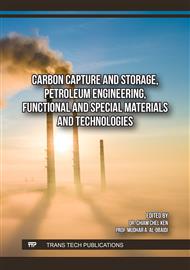[1]
M. Lawrence, E. Fodde, K. Paine, and P. Walker, "Hygrothermal performance of an experimental hemp-lime building," Key Eng. Mater., vol. 517, p.413–421, 2012.
DOI: 10.4028/www.scientific.net/KEM.517.413
Google Scholar
[2]
I. Diaw, M. Faye, S. Bodian, and V. Sambou, "Effects of Chemical Treatment on the Physical Properties of Typha," Fluid Dyn. Mater. Process., vol. 18, no. 5, p.1409–1418, 2022.
DOI: 10.32604/fdmp.2022.021968
Google Scholar
[3]
S. Benfratello, C. Capitano, G. Peri, G. Rizzo, G. Scaccianoce, and G. Sorrentino, "Thermal and structural properties of a hemp-lime biocomposite," Constr. Build. Mater., vol. 48, p.745–754, 2013.
DOI: 10.1016/j.conbuildmat.2013.07.096
Google Scholar
[4]
B. Mazhoud, F. Collet, S. Pretot, and J. Chamoin, "Hygric and thermal properties of hemp-lime plasters," Build. Environ., vol. 96, p.206–216, 2016.
DOI: 10.1016/j.buildenv.2015.11.013
Google Scholar
[5]
L. Arnaud and E. Gourlay, "Experimental study of parameters influencing mechanical properties of hemp concretes," Constr. Build. Mater., vol. 28, no. 1, p.50–56, 2012.
DOI: 10.1016/j.conbuildmat.2011.07.052
Google Scholar
[6]
B. Çomak, A. Bideci, and Ö. Salli Bideci, "Effects of hemp fibers on characteristics of cement based mortar," Constr. Build. Mater., vol. 169, p.794–799, 2018.
DOI: 10.1016/j.conbuildmat.2018.03.029
Google Scholar
[7]
M. Khazma, A. Goullieux, R. M. Dheilly, A. Rougier, and M. Quéneudec, "Optimization of flax shive-cementitious composites: Impact of different aggregate treatments using linseed oil," Ind. Crops Prod., vol. 61, p.442–452, 2014.
DOI: 10.1016/j.indcrop.2014.07.041
Google Scholar
[8]
J. Page, F. Khadraoui, M. Boutouil, and M. Gomina, "Multi-physical properties of a structural concrete incorporating short flax fibers," Elsevier Ltd, 2017.
DOI: 10.1016/j.conbuildmat.2017.02.124
Google Scholar
[9]
M. Rahim et al., "Characterization of flax lime and hemp lime concretes: Hygric properties and moisture buffer capacity," Energy Build., vol. 88, p.91–99, 2015.
DOI: 10.1016/j.enbuild.2014.11.043
Google Scholar
[10]
C. Asasutjarit, J. Hirunlabh, J. Khedari, S. Charoenvai, B. Zeghmati, and U. C. Shin, "Development of coconut coir-based lightweight cement board," Constr. Build. Mater., vol. 21, no. 2, p.277–288, 2007.
DOI: 10.1016/j.conbuildmat.2005.08.028
Google Scholar
[11]
V. M. John, M. A. Cincotto, C. Sjöström, V. Agopyan, and C. T. A. Oliveira, "Durability of slag mortar reinforced with coconut fibre," Cem. Concr. Compos., vol. 27, no. 5, p.565–574, 2005.
DOI: 10.1016/j.cemconcomp.2004.09.007
Google Scholar
[12]
E.E.C.H. KOUAKOU, M.O. BOFFOUE, A.C. DJOHORE, K.C. KOUADIO, "Experimntal Analysis of the mechanical behavior of clay-cement blocks reinforced with coconut fibers," J. Eng. Stud. Res., vol. 27, no. 2, p.51–60, 2021.
DOI: 10.29081/jesr.v27i2.272
Google Scholar
[13]
Y. Dieye, V. Sambou, M. Faye, A. Thiam, M. Adj, and D. Azilinon, "Thermo-mechanical characterization of a building material based on Typha Australis," J. Build. Eng., vol. 9, no. 2017, p.142–146, 2017.
DOI: 10.1016/j.jobe.2016.12.007
Google Scholar
[14]
A. S. Diaw, H. M. Bal, O. Diallo, M. B. Ndiaye, M. Wade, and S. Gaye, "Thermophysical Characterization of Typha's Concrete for its Integration into Construction," J. Build. Constr. Plan. Res., vol. 09, no. 01, p.56–65, 2021.
DOI: 10.4236/jbcpr.2021.91005
Google Scholar
[15]
I. Diaw, M. Faye, S. Bodian, and V. Sambou, "Characterization of cement-reinforced Typha-clay composites," J. Sci. Eng. Res., vol. 8, no. 12, p.123–128, 2021.
Google Scholar
[16]
L. Ba et al., "Experimental Investigation of Thermal and Mechanical Properties of Clay Reinforced with Typha australis: Influence of Length and Percentage of Fibers," Waste and Biomass Valorization, vol. 12, no. 5, p.2723–2737, 2021.
DOI: 10.1007/s12649-020-01193-0
Google Scholar
[17]
P. Tronet, T. Lecompte, V. Picandet, and C. Baley, "Study of lime hemp composite precasting by compaction of fresh mix - An instrumented die to measure friction and stress state," Powder Technol., vol. 258, p.285–296, 2014.
DOI: 10.1016/j.powtec.2014.03.002
Google Scholar
[18]
S. Amziane, F. Collet, M. Lawrence, C. Magniont, V. Picandet, and M. Sonebi, "Recommendation of the RILEM TC 236-BBM: characterisation testing of hemp shiv to determine the initial water content, water absorption, dry density, particle size distribution and thermal conductivity," Mater. Struct., vol. 50, no. 3, p.1–11, 2017.
DOI: 10.1617/s11527-017-1029-3
Google Scholar
[19]
C. Niyigena, "Variability in the performance of hemp concretes according to the characteristics of the hemp fiber produced in Auvergne", Doctoral thesis, Université Blaise Pascal-Clermont II, 2016.
Google Scholar
[20]
A. Youssef, "Mechanical study of lime/hemp mixes to take into account in structural calculations for light structures," Doctoral thesis, Université Bretagne Loire, 2017.
Google Scholar
[21]
C. Niyigena et al., "Variability of the mechanical properties of hemp concrete", Mater. Today Commun, vol. 7, p.122–133, 2016.
DOI: 10.1016/j.mtcomm.2016.03.003
Google Scholar


